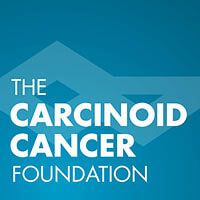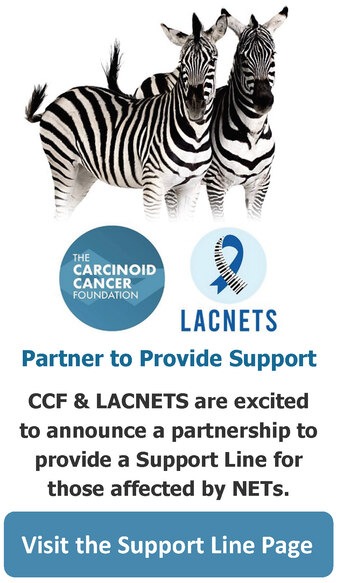TREATMENTS – OTHER
Hope for the patients with carcinoid syndrome: A diagnostic tool to help neuroendocrine cancer patients
Biochemical assessment of niacin deficiency among carcinoid cancer patients. (Abstract)
Shah GM, Shah RG, Veillette H, Kirkland JB, Pasieka JL, Warner RR.
Am J Gastroenterol. 2005 Oct;100(10):2307-14.
(Full Text) with permission from the authors.
It has been shown that giving niacin supplementation to neuroendocrine cancer patients not only resolves several common symptoms of carcinoid/neuroendocrine tumors(NETs) and pellagra, such as skin lesions and diarrhea/ steatorrhea, but also generally improves the health of the NET patients (10, 12, 29). Therefore, our results warrant that niacin status should be determined for all NET patients, so that active niacin replacement could be provided to biochemically niacin-deficient patients. In areas of the world where preformed niacin is not added to the food supply and screening of niacin status is not possible, all carcinoid patients should be supplemented with niacin as a preventative therapy.
TREATMENTS – BIOTHERAPY – SOMATOSTATIN
About Lanreotide (Somatuline Depot)
This is the link to the Ipsen US website where you can find more information about Somatuline Depot: http://www.ipsenus.com/
For information about Ipsen’s comprehensive patient support program, Ipsen Cares, helping patients get access to the medications and services they need, click here.
About Octreotide (Sandostatin)
This link is a to the Novartis Oncology website. This site has disease and product information for the US and International health-care professional as well as general information about Carcinoid/Vipoma for patients and caregivers.
Information site for carcinoid patients by Novartis. This site, intended for the newly diagnosed and those living with carcinoid syndrome, features “questions to ask your doctor” and a sign-up program to receive updated information from Novartis. Take a look at the Resources section (http://www.carcinoid.com/info/resources/downloads.jsp) to see the detailed scientific information in the form of flash animations.
For comprehensive information regarding the use of the somatostatin analogue Sandostatin in the forms of subcutaneous injection (SC), long-acting injection(Sandostatin LAR) and continuous subcutaneous infusion via a pump
(pump-based therapy) read the following newly published paper by Dr. Eugene Woltering (2005)
A discussion on the utility of various routes of administration of octreotide acetate (Full text access with permission from the author)
Generic Octreotide:
Teva Pharmaceuticals
Supplies short-acting octreotide.
TREATMENTS – BIOTHERAPY – ALPHA
Combination Therapy with Octreotide and Alpha-interferon
Comments by Richard R.P. Warner MD
TREATMENTS – SURGERY – ANESTHESIA
Anesthesia During Labor (Full Text)
Anesthesia for patients with carcinoid syndrome (Abstract)
This link is to an abstract on PubMed.
Vaughan DJ, Brunner Mct on PubMed. D.
Int Anesthesiol Clin. 1997 Fall;35(4):129-42.
“…..Carcinoid syndrome, although rare, can create serious problems to the anesthetist, both by the nature and variability of clinical manifestations and by the complications that can occur peroperatively……………………….The severity of symptoms does not predict the severity of perioperative complications, so that patients with minor preoperative symptoms may have significant intraoperative complications. …………………….The keys to successful anesthetic management of patients with carcinoid syndrome are good communication between endocrinologist, anesthetist, and surgeon and preoperative optimization of the patient……………Octreotide has largely replaced the use of other drugs both for symptomatic control and acute treatment of the symptoms associated with carcinoid syndrome……”
Octreotide treatment of carcinoid hypertensive crisis (Abstract)
Warner RR, Mani S, Profeta J, Grunstein E.
Mt Sinai J Med. 1994 Sep;61(4):349-55.”
“…….We suggest that hypertensive as well as hypotensive carcinoid crises respond to octreotide and that this agent should be considered for prophylactic and emergency use in all carcinoid syndrome patients prior to and during anesthesia and surgery.”
Perianaesthetic risks and outcomes of abdominal surgery for metastatic carcinoid tumours
(Full text PDF)
By Kinney MA, Warner ME, Nagorney DM, Rubin J, Schroeder DR, Maxson PM, Warner MA.
Br J Anaesth. 2001 Sep;87(3):447-52.
TREATMENTS – SURGERY – LIVER
Chemoembolization and Bland Embolization of Neuroendocrine Tumor Metastases to the Liver (Full text)
J Vasc Interv Radiol. 2007 Jul;18(7):847-55
Ruutiainen AT, Soulen MC, Tuite CM, Clark TW, Mondschein JI, Stavropoulos SW, Trerotola SO.
Division of Interventional Radiology, University of Pennsylvania, 1 Silverstein, Philadelphia, PA 19104, USA.
(Abstract)
CONCLUSIONS: Chemoembolization was not associated with a higher degree of toxicity than bland embolization. Chemoembolization demonstrated trends toward improvement in TTP, symptom control, and survival. Based on these results, a multicenter prospective randomized trial is warranted
Chemoembolization for Hepatic Malignancies
Full Text PDF
by Michael C. Soulen, MD, Associate Professor of Radiology & Surgery, University of Pennsylvania, Philadelphia, PA
Chemoembolization Information
Provided by Radiology Info and Radiological Society of North America, Inc. (RSNA)
Chemoembolization, radiofrequency ablation (RFA) and other treatments for liver metastases.
Information about Chemoembolization, Radiofrequency Ablation, Radioisotope (Y90) (SirSpheres, TheraSpheres,) and other surgical treatments targeted for liver tumors
- Yttrium–90 microsphere radioembolization is a new non-surgical procedure used to treat inoperable liver cancer by delivering targeted, internal radiation For Medical Centers in the US that peform
Theraspheres CLICK HERE
SirSpheres CLICK HERE
Prolonged survival after hepatic artery embolization in patients with midgut carcinoid syndrome. (abstract)
by Swärd C, Johanson V, Nieveen van Dijkum E, Jansson S, Nilsson O, Wängberg B, Ahlman H, Kölby L on April 10, 2009 in British Journal of Surgery
Conclusion:
Hepatic Artery Embolization is safe, provides good control of hormonal symptoms, and prolongs survival in biochemically responsive patients. It is a valuable palliative option for patients with midgut carcinoid syndrome due to liver metastases and can be repeated in patients with a favourable response to the first procedure. Copyright (c) 2009 British Journal of Surgery Society Ltd. Published by John Wiley & Sons, Ltd.PMID: 19358175 [PubMed – as supplied by publisher].
Radio Frequency Ablation (RFA) Cleveland Clinic
The following pages contain information for patients about the Liver Tumor Radio Frequency Ablation Program. The information will answer questions patients may ask when considering a new treatment method.
Radiofrequency ablation (RFA) Information
Provided by Liver Tumor Ablation Program at the University of California, San Francisco
Radiofrequency Ablation of Liver Tumors
Provided by Radiology Info and Radiological Society of North America, Inc. (RSNA)
SIR-Spheres (Yttrium 90, Y-90, targeted for liver tumors)
A Patient’s Guide to SIRT in English
A Patient’s Guide to SIRT in Spanish
What are SIR-Spheres?
SIR-Spheres are tiny polymer (plastic) beads (about one third the diameter of a strand of hair) that are combined with yttrium-90, a radioisotope that emits pure beta radiation. Y90 (yttrium-90) has a “half life” of about 64 hours, that is, every 64 hours the level of radiation falls by one half until it is effectively gone after 2 weeks. The radiation from Y90 penetrates an average of only 2.5 mm (approximately 1/16 of an inch) in tissue. After injection into the artery supplying blood to the tumors, the spheres are trapped in the tumor’s vascular bed, where they destroy the tumor cells by delivering the beta radiation. The radiation is targeted to the tumor and after 14 days the majority of the radiation effect has occurred. SIR-Spheres are considered a regional treatment as the radiation is directed to the liver and does not affect other organs in the body.
TREATMENTS – RADIOISOTOPE
Erasmus MC Lutetium 177 Treatment *
Moleculare RadioTherapy (Website with contact information, click on the globe to the right of Contact at the top of the page to translate the website into English)
Information about the Receptor therapy given to patients in the Netherlands …… Read More
How to Reach us Click Here
Postal address
P.O. box 2040
3000 CA Rotterdam, NL
Street address
Dr. Molewaterplein 40
3015 GD Rotterdam, NL
Direct dial +31-10-4635963
Fax number +31-10-4635997
Comment: Head of Department
Prof. Dr. Eric.P. Krenning
Many European Countries now have systemic radioistotope therapies available:
Netherlands, UK, Switzerland, Germany, Canada and Sweden.
Please contact ENETS ( the European Neuroendocrine Tumor Society) for location and contact information. https://www.enets.org/
Radioisotope Treatment with LU -177
See information about this treatment and contact information
It is a very thorough guide to the treatment process and clearly spells out the steps that need to be taken to get to Erasmus MC.
http://www.prrt.nl/index.php?lang=en
Systemic Radioisotope treatment now available in the US.
“High Dose Indium-111 Pentetreotide (Octreotide) Therapy in Somatostatin Receptor Expressing Neuroendocrine Neoplasms.”
High-dose 111In-Pentetreotide (~500 mCi/patient) is now offered in the U.S. for therapy in somatostatin receptor expressing neuroendocrine tumors. This is based on the Investigational New Drug (IND) application filed with FDA. Using this innovative method of cancer therapy, a somatostatin receptor analog (called Pentetreotide) is labeled with a high dose of a radioactive element called Indium-111. Pentetreotide will carry Indium-111 to the site of the tumor and attaches to the receptor site located on the cell membrane. The next step is internalization of the compound into the cell cytoplasm and next to the cell nucleus. Radioactivity is then deposited in this region and causes damage to the DNA molecules located in the nucleus of the cancer cells. The net effect will be initial dysfunction of the tumor cells, followed by prevention of further tumor growth and leading to cell death.
This therapy can be applied to the category of neuroendocrine tumors which include Carcinoid, Islet Cell Carcinoma of the Pancreas, Oat Cell Carcinoma of the Lung, and Medullary Thyroid Carcinoma” .
The principle investigator of this program is Dr. Ebrahim S. Delpassand and the project is in collaboration with Excel diagnostic Imaging Clinics, St. Luke’s Episcopal Hospital and RadioIsotope Therapy of America (RITA) Foundation in Houston.
For further information regarding this treatment, you can contact Ms. Susan Cork, clinical coordinator of the project at: 713-341-3239.
scork@exceldiagnostics.com


